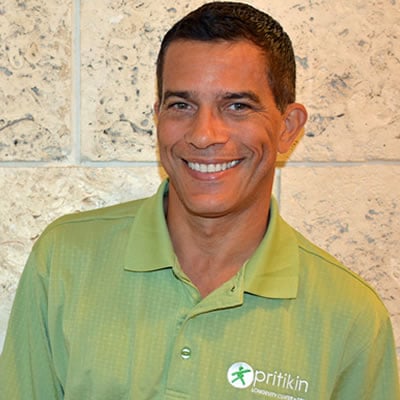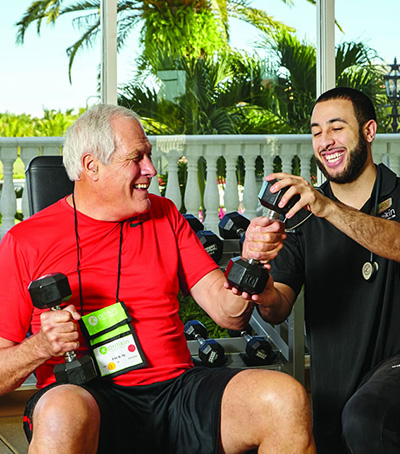How To Do Squats Without Knee Pain
To help you get into proper form, imagine that you’re sitting down in a chair and getting back up again. You’re mostly using your hips, right? The squat is a hips movement. Think of the knees as just going along as passengers, not the drivers.
Do squats right, and they’ll do wonders for your lower body muscles, especially your butt and thighs.

Do them wrong, and oh, do they hurt.
“Every time a new group of guests arrives at the Pritikin Longevity Center, I have a few, sometimes several, tell me, ‘I’d love to exercise and get fit, but I can’t because it hurts,’” says Jamie Costello, MSC, Director of Exercise at Pritikin.
“By the time they leave one or two weeks later, they’ve learned proper form for the exercises that used to put them in pain, including squats. The day-to-day coaching makes exercise possible again.”
How To Do Squats Without Knee Pain
When doing squats, as Pritikin’s 1-minute video shows, it’s really important to not let your knees bend forward beyond the tips of your toes.
“Our knees bend forward too far because we’re putting most of our weight on our toes, which puts more stress on our knees. What we should be doing is using our hips, not our toes,” explains Jamie.
To help you get into proper form, imagine that you’re sitting down in a chair and getting back up again. You’re mostly using your hips, right? The squat is a hips movement. Think of the toes and knees as just going along for the ride.
How To Do Squats Without Back Pain
To prevent back pain when doing squats, you want “a nice straight back throughout the movement,” says Jamie. Be especially mindful that you aren’t overarching your lower back, or lumbar region.
“Sometimes, it takes a lot of practice,” acknowledges Jamie. “Some of our guests here at Pritikin have backs that have been out of alignment for so long that they don’t really know what good alignment is, or what it feels like, let alone how to achieve it. The one-on-one attention they receive here is a huge help.”
Summing Up | How To Do Squats
Without Knee Pain and Back Pain
Squats are among the most popular exercises because when done right, they not only help you look better (who doesn’t want a nicer-looking butt?), they make life better.
Squatting is a movement we use in real-life activities every day, and constantly. We squat to sit in chairs. We squat on couches. We squat to get into our cars. We squat when gardening. We squat when picking up children and grandchildren. And certainly, we squat when sitting on the toilet.
It’s no exaggeration to say that when we squat well, we live well.
Get basic guidelines for doing squats without knee pain and back pain in the Pritikin Longevity Center’s 1-minute video.
Strength Exercises |
Key Benefits, Recommendations
We tend to know the benefits of cardiovascular exercises like jogging or swimming. They improve heart function and circulation. They also help lower blood pressure and reduce risk of obesity, diabetes, and heart disease.
But many of us don’t fully understand, or appreciate, the benefits of strength (also called resistance) exercises such as squats.
Strength exercises are exercises that strengthen all the major muscle groups of the body. If you do them regularly, you’ll reap huge benefits:
- You’ll feel your muscles grow firmer and more powerful as your endurance increases.
- Your coordination, agility, and balance improve.
- You can better perform a myriad of daily activities – like climbing stairs, getting in and out of your car, carrying groceries, playing golf, hiking the countryside, and playing basketball with the kids. You do them all with greater ease, confidence, and joy.
- As you increase strength and agility, you reduce the chance of falls and injuries.
- You improve your body composition. That’s because as you build lean muscle, you reduce body fat. As you lower your percentage of body fat, you lower your risk of heart disease, obesity, diabetes, and even some forms of cancer.
- Finally, strength training helps prevent bone loss, even in those with osteoporosis.
Along with all the above, you’ll also look and feel better. There’ll be more pep in your step.

“And your body—from calves and thighs to butt and stomach to chest and arms—will definitely look fitter and trimmer,” encourages Pritikin’s Exercise Director Jamie Costello.
“But the key to all these benefits is not just doing strength exercises, but doing them right. If done incorrectly, they could create pain and keep you from exercising. They might even cause injury, which would also put you on the sidelines,” cautions Jamie.
To accentuate the positive benefits and eliminate the negatives, “we focus on one-on-one guidance here at Pritikin,” says Jamie. “Within a week or two, our guests are noticing that their muscles are automatically falling into correct form, and they’re feeling the benefits.”
Pritikin Basic 8
In addition to the squat, there are 7 other exercises that are part of the Pritikin Video Series for strengthening the body’s major muscle groups.
| All 8 are: |
| 1. Squat: When done correctly, the squat exercise not only helps you look better (who doesn’t want a nicer-looking butt?), it makes life better. That’s because squatting is a movement we use in all sorts of everyday activities. |
| 2. Calf Raise: Calf raises are a great exercise for toning up legs. What’s more, calf raises train your body to maintain balance, which can help you avoid nasty falls. Watch the Calf Raises Video: How To Shape Up Your Legs Without Pain » |
| 3. Chest Press: The chest press not only tones your chest, shoulders, and arms, it strengthens your core. But it’s really important to do the chest press correctly to avoid pain and injury. Watch the Chest Press Video: Tone Your Upper Body Without Pain or Injury » |
| 4. One Arm Dumbbell Row: This exercise builds a strong back. It also strengthens your shoulders, upper arms, and core. You’ll be able to walk and stand longer – at football games, at museums – without having to contend with an aching back. Watch the One Arm Dumbbell Row Video: Strengthen Your Back Without Pain or Injury » |
| 5. 45-Degree Shoulder Raise: The 45-degree shoulder raise can power up your shoulder muscles. You’ll be able to do a lot of things more easily, like lifting your carry-on into the overhead bins of planes. Watch the 45-Degree Shoulder Raise Video: Powerful Shoulders without Pain |
| 6. Reverse Fly – Scapula Retraction: The scapula retraction is a great exercise for improving your posture. The exercise experts at Pritikin recommend using bands. Essentially, you’re moving your shoulder blades (scapula) back toward your spine. Watch the Scapula Retraction Video: Reverse Fly | Build Good Posture and Strong Shoulders Without Pain » |
| 7. Standard Crunch: Here’s an important exercise for your core. Your Pritikin video will show you how to start with the simplest and safest movements, and from there progress to more challenging forms. Watch the Standard Crunch Video: How To Do Crunches Without Hurting Yourself » |
| 8. Prone Leg Lift: The prone leg lift is a superb all-purpose exercise for your lower body. It strengthens the lower back, glutes (the three muscles that make up the buttocks), hamstrings, and core. Watch the Video: How To Do Prone Leg Lifts Correctly » |
At the Pritikin Longevity Center, the #1 priority is performing every type of exercise correctly to avoid pain and injury.